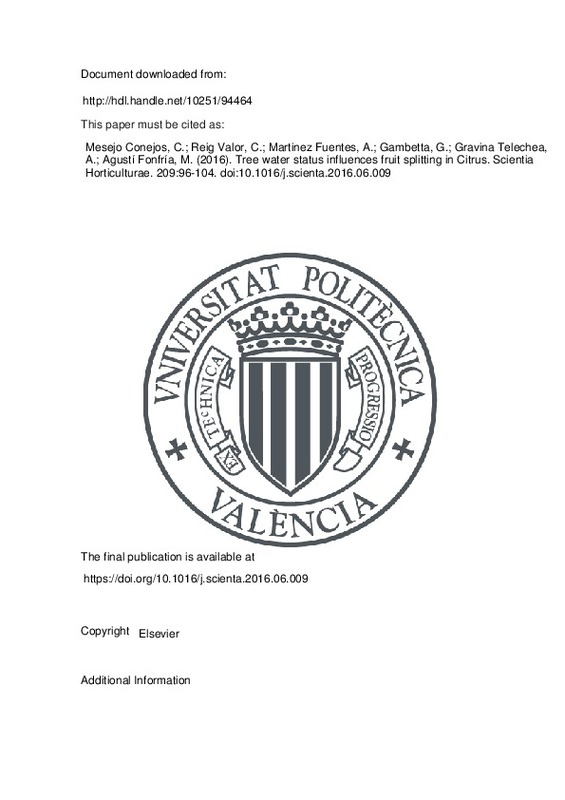JavaScript is disabled for your browser. Some features of this site may not work without it.
Buscar en RiuNet
Listar
Mi cuenta
Estadísticas
Ayuda RiuNet
Admin. UPV
Tree water status influences fruit splitting in Citrus
Mostrar el registro sencillo del ítem
Ficheros en el ítem
| dc.contributor.author | Mesejo Conejos, Carlos
|
es_ES |
| dc.contributor.author | Reig Valor, Carmina
|
es_ES |
| dc.contributor.author | Martínez Fuentes, Amparo
|
es_ES |
| dc.contributor.author | GAMBETTA, GIULIANA
|
es_ES |
| dc.contributor.author | Gravina Telechea, Alfredo
|
es_ES |
| dc.contributor.author | Agustí Fonfría, Manuel
|
es_ES |
| dc.date.accessioned | 2018-01-11T09:46:44Z | |
| dc.date.available | 2018-01-11T09:46:44Z | |
| dc.date.issued | 2016 | es_ES |
| dc.identifier.issn | 0304-4238 | es_ES |
| dc.identifier.uri | http://hdl.handle.net/10251/94464 | |
| dc.description.abstract | [EN] Fruit splitting or cracking is a major physiological disorder in fruit trees markedly influenced by environmental conditions, but conclusive data still are required to provide a definite explanation and preventive measures. Changes in climatic conditions critically influence fruit splitting incidence. We studied plant-soil-ambient water relations in splitting-prone citrus grown under 4 contrasting environmental conditions (climate type and soil), in Spain and Uruguay, over a six years period. Automatic trunk and fruit diameter measurements (trunk and fruit growth rate and maximum daily trunk shrinkage), which are a tree water status indicator, together with factors modifying the tree and fruit water relationship (temperature, ET, rainfall, soil texture, soil moisture, rootstock and xylem anatomy) were studied and correlated with splitting. A close fruit splitting and soil texture relationship was found, inversely correlated with clay and silt percentages, and positively with those for sand. Under 85%-sand soil conditions, slight changes in soil moisture due to fluctuations in temperature, ET, or rainfall changed trunk and fruit growth rate patterns during few hours and induced splitting. Splitting incidence was higher in trees with larger xylem vessels in the fruit peduncle due to rootstock ('Carrizo' and 'C-35' citrange being higher than 'FA-5', 'Cleopatra' and Poncirus trifoliata). Finally, reducing the frequency of irrigation by half increased midday canopy temperatures (similar to 5 degrees C) and splitting (+15%). We conclude that irregularities in the tree water status, due to interactions among soil moisture, rootstock and climatic conditions, leads to a number of substantial changes in fruit growth rate increasing the incidence of fruit splitting. (C) 2016 Elsevier B.V. All rights reserved. | es_ES |
| dc.language | Inglés | es_ES |
| dc.publisher | Elsevier | es_ES |
| dc.relation.ispartof | Scientia Horticulturae | es_ES |
| dc.rights | Reconocimiento - No comercial - Sin obra derivada (by-nc-nd) | es_ES |
| dc.subject | Citrus | es_ES |
| dc.subject | Climate | es_ES |
| dc.subject | Physiological disorder | es_ES |
| dc.subject | Splitting | es_ES |
| dc.subject | Trunk growth rate | es_ES |
| dc.subject | Soil | es_ES |
| dc.subject.classification | PRODUCCION VEGETAL | es_ES |
| dc.title | Tree water status influences fruit splitting in Citrus | es_ES |
| dc.type | Artículo | es_ES |
| dc.identifier.doi | 10.1016/j.scienta.2016.06.009 | es_ES |
| dc.rights.accessRights | Abierto | es_ES |
| dc.date.embargoEndDate | 2018-09-19 | es_ES |
| dc.contributor.affiliation | Universitat Politècnica de València. Departamento de Producción Vegetal - Departament de Producció Vegetal | es_ES |
| dc.description.bibliographicCitation | Mesejo Conejos, C.; Reig Valor, C.; Martinez Fuentes, A.; Gambetta, G.; Gravina Telechea, A.; Agustí Fonfría, M. (2016). Tree water status influences fruit splitting in Citrus. Scientia Horticulturae. 209:96-104. doi:10.1016/j.scienta.2016.06.009 | es_ES |
| dc.description.accrualMethod | S | es_ES |
| dc.relation.publisherversion | https://doi.org/10.1016/j.scienta.2016.06.009 | es_ES |
| dc.description.upvformatpinicio | 96 | es_ES |
| dc.description.upvformatpfin | 104 | es_ES |
| dc.type.version | info:eu-repo/semantics/publishedVersion | es_ES |
| dc.description.volume | 209 | es_ES |
| dc.relation.pasarela | S\316415 | es_ES |







![[Cerrado]](/themes/UPV/images/candado.png)

